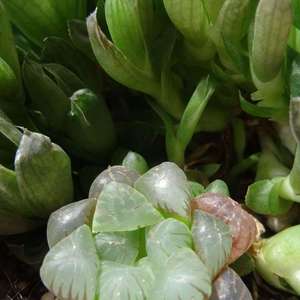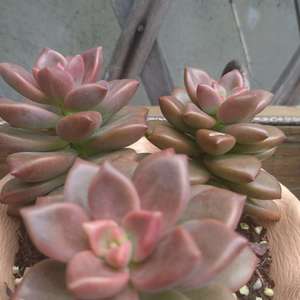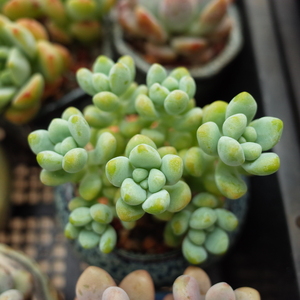求助
Khim_ali
2018年07月16日

Im new to propagating succulents and its day 5 but the plant didnt go well. I wait till a pedal falls off or I take the bottom ones and twist it to get them off. I tried drying it in my house for 2-3 days on top of soil with some sunlight by the window but the plant began to rot and get all soft/mushy so I tried doing it outside drying them for 2-3 days then misting them with water but my plant has turned black can someone gove me tips on propagating ive been trying but its not going well. Also when propagating is it norml for the plant to get soft and mushy?

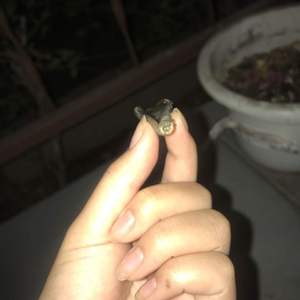


0
0
Khim_ali:@Liz Lynch okay I’ll give t a few more days , thank you!!
Liz Lynch:Give it a few more days.... but when you say soft - how soft? Softness usually means to much water 😊
Liz Lynch:I reckon this still may have potential to go
2018年07月13日

铜钱草采用半土半水栽培的,之前在室内养的一小盆,叶子时常枯萎,后来家里有一个废弃的不锈钢盆,正好就拿来养铜钱草了。盆子的土是用1:2的沙子和园土配的,铜钱草栽种好以后就直接浇水,以高出土面3公分左右为宜。接着放到散射光处缓盆,大概3-5天移到室外树下,没有刻意遮阴或晒太阳,后期养护以盆内没水就加为主,没有天数规定,至今已爆盆,而且叶子也很大,已经分盆~
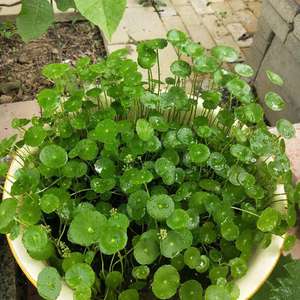

0
0
文章
Miss Chen
2018年07月11日

Description: This herbaceous perennial plant is 2-6' tall and unbranched, except sometimes toward the apex, where the flowers occur. The central stem is relative stout, pale green, terete, and usually short-pubescent (less often glabrous). The opposite leaves are up to 8" long and 3½" wide, broadly oblong in shape, and smooth along their margins. The upper leaf surface is pale-medium to dark green and hairless above, while the lower leaf surface is densely covered with woolly hairs that are very short. There is a prominent central vein along the length of each leaf, and finer side veins that radiate outward toward the smooth margins. When either the central stem or leaves are torn, a milky sap oozes out that has variable toxicity in the form of cardiac glycosides.
Umbels of flowers, each about 2½-4" across, emerge from the axils of the upper leaves. These flowers are quite fragrant, with a scent resembling violets or pansies, and they range in color from faded light pink to reddish purple. Each flower is about ¼" across, consisting of 5 reflexed petals and 5 raised hoods with curved horns. The hoods are more light-colored than the petals. The pedicels of the flowers are light green to pale red and hairy. The blooming period lasts about 1-1½ months from early to mid-summer. The seedpods (follicles) are 3-4" long, broadly lanceoloid, and covered with soft prickles and short woolly hairs. At maturity, each seedpod split along one side to release numerous seeds that have large tufts of white hair. Dispersion of seed is by wind. The root system has long creeping rhizomes, promoting the vegetative spread of this plant.

Cultivation: The preference is full sun, rich loamy soil, and mesic conditions, but this robust plant can tolerate a variety of situations, including partial sun and a high clay or sand content in the soil. Under ideal conditions, Common Milkweed can become 6' tall and spread aggressively, but it is more typically about 3-4' tall. This plant is very easy to grow once it becomes established.
Range & Habitat: The native Common Milkweed occurs in every county of Illinois and it is quite common (see Distribution Map). Habitats include moist to dry black soil prairies, sand prairies, sand dunes along lake shores, thickets, woodland borders, fields and pastures, abandoned fields, vacant lots, fence rows, and areas along railroads and roadsides. This plant is a colonizer of disturbed areas in both natural and developed habitats.

Faunal Associations: The flowers are very popular with many kinds of insects, especially long-tongued bees, wasps, flies, skippers, and butterflies, which seek nectar. Other insect visitors include short-tongued bees, various milkweed plant bugs, and moths, including Sphinx moths. Among these, the larger butterflies, predatory wasps, and long-tongued bees are more likely to remove the pollinia from the flowers. Some of the smaller insects can have their legs entrapped by the flowers and die. Common Milkweed doesn't produce fertile seeds without cross-pollination. The caterpillars of Danaus plexippes (Monarch Butterfly) feed on the foliage, as do the caterpillars of a few moths, including Enchaetes egle (Milkweed Tiger Moth), Cycnia inopinatus (Unexpected Cycnia), and Cycnia tenera (Delicate Cycnia). Less common insects feeding on this plant include Neacoryphus bicrucis (Seed Bug sp.) and Gymnetron tetrum (Weevil sp.); see Insect Table for other insect feeders). Many of these insects are brightly colored – a warning to potential predators of the toxicity that they acquired from feeding on milkweed. Mammalian herbivores don't eat this plant because of the bitterness of the leaves and their toxic properties.

Photographic Location: The photographs were taken at Meadowbrook Park in Urbana, Illinois, and along a roadside ditch in Champaign, Illinois.
Comments: Depending on the local ecotype, Common Milkweed is highly variable in appearance. The color of the flowers may be highly attractive, or faded and dingy-looking. This plant is often regarded as a weed to be destroyed, but its flowers and foliage provide food for many kinds of insects. Common Milkweed can be distinguished from other milkweeds by its prickly follicles (seedpods) – other Asclepias spp. within Illinois have follicles that are smooth, or nearly so.
Umbels of flowers, each about 2½-4" across, emerge from the axils of the upper leaves. These flowers are quite fragrant, with a scent resembling violets or pansies, and they range in color from faded light pink to reddish purple. Each flower is about ¼" across, consisting of 5 reflexed petals and 5 raised hoods with curved horns. The hoods are more light-colored than the petals. The pedicels of the flowers are light green to pale red and hairy. The blooming period lasts about 1-1½ months from early to mid-summer. The seedpods (follicles) are 3-4" long, broadly lanceoloid, and covered with soft prickles and short woolly hairs. At maturity, each seedpod split along one side to release numerous seeds that have large tufts of white hair. Dispersion of seed is by wind. The root system has long creeping rhizomes, promoting the vegetative spread of this plant.

Cultivation: The preference is full sun, rich loamy soil, and mesic conditions, but this robust plant can tolerate a variety of situations, including partial sun and a high clay or sand content in the soil. Under ideal conditions, Common Milkweed can become 6' tall and spread aggressively, but it is more typically about 3-4' tall. This plant is very easy to grow once it becomes established.
Range & Habitat: The native Common Milkweed occurs in every county of Illinois and it is quite common (see Distribution Map). Habitats include moist to dry black soil prairies, sand prairies, sand dunes along lake shores, thickets, woodland borders, fields and pastures, abandoned fields, vacant lots, fence rows, and areas along railroads and roadsides. This plant is a colonizer of disturbed areas in both natural and developed habitats.

Faunal Associations: The flowers are very popular with many kinds of insects, especially long-tongued bees, wasps, flies, skippers, and butterflies, which seek nectar. Other insect visitors include short-tongued bees, various milkweed plant bugs, and moths, including Sphinx moths. Among these, the larger butterflies, predatory wasps, and long-tongued bees are more likely to remove the pollinia from the flowers. Some of the smaller insects can have their legs entrapped by the flowers and die. Common Milkweed doesn't produce fertile seeds without cross-pollination. The caterpillars of Danaus plexippes (Monarch Butterfly) feed on the foliage, as do the caterpillars of a few moths, including Enchaetes egle (Milkweed Tiger Moth), Cycnia inopinatus (Unexpected Cycnia), and Cycnia tenera (Delicate Cycnia). Less common insects feeding on this plant include Neacoryphus bicrucis (Seed Bug sp.) and Gymnetron tetrum (Weevil sp.); see Insect Table for other insect feeders). Many of these insects are brightly colored – a warning to potential predators of the toxicity that they acquired from feeding on milkweed. Mammalian herbivores don't eat this plant because of the bitterness of the leaves and their toxic properties.

Photographic Location: The photographs were taken at Meadowbrook Park in Urbana, Illinois, and along a roadside ditch in Champaign, Illinois.
Comments: Depending on the local ecotype, Common Milkweed is highly variable in appearance. The color of the flowers may be highly attractive, or faded and dingy-looking. This plant is often regarded as a weed to be destroyed, but its flowers and foliage provide food for many kinds of insects. Common Milkweed can be distinguished from other milkweeds by its prickly follicles (seedpods) – other Asclepias spp. within Illinois have follicles that are smooth, or nearly so.
0
0
文章
Miss Chen
2018年07月11日

Description: This herbaceous perennial plant forms both basal leaves and erect to ascending stems with alternate leaves; the latter are 2-4' tall, branching occasionally. The stems are grayish green to nearly white, densely canescent, and terete, becoming more glabrous and slightly woody with age. Both the basal and lower alternate leaves are 2–4½" long and ¾–1¾" across (excluding their petioles); they are bipinnatifid to tripinnatifid. These leaves are deeply divided into primary lobes, while their ultimate lobes are more shallow and cleft. The ultimate lobes are 2-4 mm. across and narrowly oblong to narrowly oblanceolate in shape, tapering abruptly into bluntly acute tips. The middle alternate leaves are less divided and slightly smaller in size, while the upper alternate leaves are simple or sparingly lobed and even smaller in size. Both the upper and lower sides of the leaves are grayish green and sparsely to moderately canescent. The basal and lower alternate leaves have long petioles, while the middle alternate leaves have shorter petioles, and the upper alternate leaves are sessile or nearly so. Like the leaves, the petioles are grayish green and canescent. The foliage of this plant has a sage-like aroma with slightly bitter overtones. The upper stems terminate in panicles of flowers. Along the primary rachises of these panicles, there are primary leafy bracts at the bases of the secondary rachises; these primary bracts are up to 1" long, linear-oblong in shape, grayish green to nearly white, and canescent.
Secondary leafy bracts also occur at the bases of the peduncles on the secondary rachises; these secondary bracts are similar to the primary leafy bracts, except they are smaller in size. Both the primary and secondary rachises of the panicles are grayish green to nearly white and moderately to densely canescent; they are flat or slightly concave along their upper sides and rounded along their lower sides. The nodding flowerheads are 3-5 mm. across and 2-3 mm. tall; they are subgloboid in shape. Each flowerhead has 20-40 perfect disk florets that are surrounded by 10-20 pistillate disk florets; both types of florets are fertile. The florets are seperated by abundant silky hairs that originate from the receptacle. The tiny corollas of these florets are tubular in shape and 5-lobed along their upper rims. Overall, the appearance of these florets is yellowish brown. Along the sides of each flowerhead, there are small appressed phyllaries (floral bracts) in several overlapping series; these floral bracts are whitish green, densely canescent, and oblong to ovate in shape. The flowerheads have short curved peduncles that are whitish green and densely canescent. The blooming period occurs from mid-summer to early autumn, lasting 2-3 weeks for a colony of plants. The florets are cross-pollinated by the wind. Afterwards, the florets are replaced by small achenes. Mature achenes are 0.5–1 mm. long, narrowly oblongoid-oblanceoloid in shape, and light brown; they lack tufts of hair. The root system consists of a taproot up to ½" across. This plant reproduces by reseeding itself.

Cultivation: The preference is full or partial sun, moist to dry-mesic conditions, and soil containing loam, clay-loam, or some gravel. The soil should be well-drained. The size of individual plants can be highly variable depending on their age, moisture conditions, and soil fertility. For a herbaceous wormwood species (Artemisia), Absinthe tends to be long-lived.
Range & Habitat: Naturalized populations of Absinthe can be found in NE Illinois and scattered counties elsewhere, where it is relatively rare (see Distribution Map). All of these naturalized plants have escaped from cultivation. Absinthe was introduced into North America from Europe as an ornamental and medicinal plant. It is still cultivated occasionally in herb gardens today. In North America, this plant is more common in the northern plains of the United States and south-central Canada, where it is regarded as a weed of pastures. Habitats include pastures, sunny fence rows, gravelly areas along railroads, old homestead sites, and waste areas. Habitats with a history of disturbance are strongly preferred. In Illinois, Absinthe has difficulty to competing with taller native plants in natural areas.

Faunal Associations: Several species of aphids are known to feed on Absinthe (Artemisia absinthium); many of these species originated from Europe. Examples include such species as Coloradoa absinthii, Coloradoa angelicae, Coloradoa artemisiae, Macrosiphoniella absinthii (Absinthe Aphid), and other Macrosiphoniella spp. (Blackman & Eastop, 2013; Robinson & Bradley, 1965). Other insects that feed on wormwood species (Artemisia spp.) include Aphis middletonii(Erigeron Root Aphid), larvae of the leaf-miner fly Calycomyza artemisiae (Wormseed Webworm), larvae of the Gelechiid moth, Scrobipalpula artemisiella (Wormseed Webworm), and larvae of the Tortricid moths Eucosma agricolana and Phaneta dorsiatomana (Hottes & Frison, 1931; Spencer & Steyskal, 1986; Marcovitch, 1916; Miller, 1987). Some grasshoppers feed on these plants as well, including Hesperotettix viridis (Meadow Purple-striped Grasshopper), Hypochloa alba (Cudweed Grasshopper), and Melanoplus angustipennis (Narrow-winged Sand Grasshopper); see Vickery & Kevan (1985). Because the foliage of Absinthe is aromatic and bitter, it is not preferred as a source of food by herbivorous mammals. However, cattle and other domesticated livestock will feed on the foliage of Absinthe if little else is available. The consumption of a large quantity of foliage is potentially harmful as it contains the neurotoxin, thujone.

Photographic Location: An herb garden at Meadowbrook Park in Urbana, Illinois.
Comments: Absinthe (Artemisia absinthium) has been used to flavor an alcoholic liquor by the same name. Excessive consumption of this liquor has the potential to cause toxic effects and its use in some countries has been banned. Absinthe is similar in appearance to several other wormseed species (Artemisia spp.); both native and non-native species are present in Illinois. A native species that occurs in sandy areas, Beach Wormwood (Artemisia campestris), can be distinguished by the longer length and narrowness of the lobes of its leaves, the sterile florets in the center of its flowerheads, and the lack of villous hairs on the receptacle of its flowerheads. The presence of the last characteristic (villous hairs on the receptacles of the flowerheads) distinguishes Absinthe from all other wormseed species in Illinois, except for Prairie Sagebrush (Artemisia frigida). Prairie Sagebrush has smaller leaves with more narrow lobes (1 mm. across or less) than Absinthe, while its flowerheads are slightly larger in size (5-6 mm. across and 3-5 mm. tall). It is primarily a western species that is rarely found in Illinois.
Secondary leafy bracts also occur at the bases of the peduncles on the secondary rachises; these secondary bracts are similar to the primary leafy bracts, except they are smaller in size. Both the primary and secondary rachises of the panicles are grayish green to nearly white and moderately to densely canescent; they are flat or slightly concave along their upper sides and rounded along their lower sides. The nodding flowerheads are 3-5 mm. across and 2-3 mm. tall; they are subgloboid in shape. Each flowerhead has 20-40 perfect disk florets that are surrounded by 10-20 pistillate disk florets; both types of florets are fertile. The florets are seperated by abundant silky hairs that originate from the receptacle. The tiny corollas of these florets are tubular in shape and 5-lobed along their upper rims. Overall, the appearance of these florets is yellowish brown. Along the sides of each flowerhead, there are small appressed phyllaries (floral bracts) in several overlapping series; these floral bracts are whitish green, densely canescent, and oblong to ovate in shape. The flowerheads have short curved peduncles that are whitish green and densely canescent. The blooming period occurs from mid-summer to early autumn, lasting 2-3 weeks for a colony of plants. The florets are cross-pollinated by the wind. Afterwards, the florets are replaced by small achenes. Mature achenes are 0.5–1 mm. long, narrowly oblongoid-oblanceoloid in shape, and light brown; they lack tufts of hair. The root system consists of a taproot up to ½" across. This plant reproduces by reseeding itself.

Cultivation: The preference is full or partial sun, moist to dry-mesic conditions, and soil containing loam, clay-loam, or some gravel. The soil should be well-drained. The size of individual plants can be highly variable depending on their age, moisture conditions, and soil fertility. For a herbaceous wormwood species (Artemisia), Absinthe tends to be long-lived.
Range & Habitat: Naturalized populations of Absinthe can be found in NE Illinois and scattered counties elsewhere, where it is relatively rare (see Distribution Map). All of these naturalized plants have escaped from cultivation. Absinthe was introduced into North America from Europe as an ornamental and medicinal plant. It is still cultivated occasionally in herb gardens today. In North America, this plant is more common in the northern plains of the United States and south-central Canada, where it is regarded as a weed of pastures. Habitats include pastures, sunny fence rows, gravelly areas along railroads, old homestead sites, and waste areas. Habitats with a history of disturbance are strongly preferred. In Illinois, Absinthe has difficulty to competing with taller native plants in natural areas.

Faunal Associations: Several species of aphids are known to feed on Absinthe (Artemisia absinthium); many of these species originated from Europe. Examples include such species as Coloradoa absinthii, Coloradoa angelicae, Coloradoa artemisiae, Macrosiphoniella absinthii (Absinthe Aphid), and other Macrosiphoniella spp. (Blackman & Eastop, 2013; Robinson & Bradley, 1965). Other insects that feed on wormwood species (Artemisia spp.) include Aphis middletonii(Erigeron Root Aphid), larvae of the leaf-miner fly Calycomyza artemisiae (Wormseed Webworm), larvae of the Gelechiid moth, Scrobipalpula artemisiella (Wormseed Webworm), and larvae of the Tortricid moths Eucosma agricolana and Phaneta dorsiatomana (Hottes & Frison, 1931; Spencer & Steyskal, 1986; Marcovitch, 1916; Miller, 1987). Some grasshoppers feed on these plants as well, including Hesperotettix viridis (Meadow Purple-striped Grasshopper), Hypochloa alba (Cudweed Grasshopper), and Melanoplus angustipennis (Narrow-winged Sand Grasshopper); see Vickery & Kevan (1985). Because the foliage of Absinthe is aromatic and bitter, it is not preferred as a source of food by herbivorous mammals. However, cattle and other domesticated livestock will feed on the foliage of Absinthe if little else is available. The consumption of a large quantity of foliage is potentially harmful as it contains the neurotoxin, thujone.

Photographic Location: An herb garden at Meadowbrook Park in Urbana, Illinois.
Comments: Absinthe (Artemisia absinthium) has been used to flavor an alcoholic liquor by the same name. Excessive consumption of this liquor has the potential to cause toxic effects and its use in some countries has been banned. Absinthe is similar in appearance to several other wormseed species (Artemisia spp.); both native and non-native species are present in Illinois. A native species that occurs in sandy areas, Beach Wormwood (Artemisia campestris), can be distinguished by the longer length and narrowness of the lobes of its leaves, the sterile florets in the center of its flowerheads, and the lack of villous hairs on the receptacle of its flowerheads. The presence of the last characteristic (villous hairs on the receptacles of the flowerheads) distinguishes Absinthe from all other wormseed species in Illinois, except for Prairie Sagebrush (Artemisia frigida). Prairie Sagebrush has smaller leaves with more narrow lobes (1 mm. across or less) than Absinthe, while its flowerheads are slightly larger in size (5-6 mm. across and 3-5 mm. tall). It is primarily a western species that is rarely found in Illinois.
0
0
文章
Miss Chen
2018年07月11日

Description: This perennial wildflower develops a rosette of basal leaves, from which there develops one or more flowering stalks about 1¾-4' tall. The blades of the basal leaves are ½-2' long and 1½-6" across; they are broadly oblong-elliptic in shape and finely crenate-serrate along their margins. The petioles of the basal leaves are often as long as the blades. The basal leaves are widely spreading and rather floppy; their margins often undulate up-and-down. The stems of Horseradish are light to medium green and glabrous. Alternate leaves become smaller in size as they ascend these stems; their blades are 1-6" long and ¼-2" across. The blades of alternate leaves are narrowly elliptic to broadly oblong-lanceolate in shape and their margins are coarsely crenate-serrate to shallowly pinnatifid; they are sessile or with short petioles. The upper blade surfaces of both basal and alternate leaves are medium to dark green and glabrous, while their lower surfaces are a more pale shade of green and glabrous below.
The central stem and upper axillary stems terminate in either racemes or panicles of flowers about 4-16" in length. The flowers bloom toward the apex of each raceme (or branch of a panicle), while seedpods develop below. Each flower spans about 1/3" (8 mm.) across, consisting of 4 white petals, 4 light green sepals, 6 stamens, and a pistil with a short style. The petals are about twice the length of the sepals. The ascending pedicels are ¼-¾" in length, light green, and glabrous, becoming longer as the seedpods develop. The central stalks and branches of the racemes and panicles are light green and glabrous. The blooming period can occur from mid-spring to mid-summer and lasts about 2 months. The flowers are replaced by cylindrical seedpods up to ¼" (6 mm.) long; each seedpod can contain up to 8 seeds. The root system consists of a stout taproot and stout rhizomes. Clonal colonies of plants are often produced.

Cultivation: The preference is full or partial sun, moist conditions, and fertile soil containing loam or silt-loam. Because of its underground rhizomes, Horseradish can spread aggressively.
Range & Habitat: The non-native Horseradish is occasional in most areas of Illinois, except in the SE section of the state, where it is rare or absent (see Distribution Map). This plant was introduced into North America from Europe during colonial times; it is native to SE Europe and parts of SW Asia. Habitats include streambanks, ditches, fence rows, low areas along roads and railroads, abandoned fields, vacant lots, disturbed open woodlands, and waste areas. Horseradish is still cultivated in gardens as a culinary herb. It is usually found in disturbed areas.

Faunal Associations: The nectar and pollen of the flowers attract small bees, flies, small butterflies, and probably other insects. Several leaf beetles (Chrysomelidae) have been observed to feed on Horseradish, specifically: Entomoscelis americana, Phaedon laevigatus, Phyllotreta armoraciae (Horseradish Flea Beetle), Phyllotreta bipustulata, Phyllotreta conjuncta, Phyllotreta cruciferae, Phyllotreta oblonga, Phyllotreta punctulata, Phyllotreta striolata, and Phyllotreta zimmermanni (see Clark et al., 2004). These species are mostly flea beetles (a subfamily of leaf beetles) that feed on the foliage and sometimes the roots. Other insect feeders include Murgantia histrionica (Harlequin Bug), the caterpillars of Lascoria ambigualis (Ambiguous Moth), and the caterpillars of Pieris rapae (Cabbage White). Because of high levels of mustard oil from the conversion of glucosinolates, Horseradish can produce toxic effects on mammalian herbivores, especially the pungent roots.
Photographic Location: A roadside ditch in NW Ohio, and the Toledo Botanical Garden in Toledo, Ohio.

Comments: In the United States, the thick roots of Horseradish are grated to flavor various sauces for food (primarily dishes of beef, pork, and seafood). Such sauces usually contain vinegar, mayonnaise, or pureed tomatoes. Because of the warm climate during summer and the long growing-season, Horseradish usually produces both seedpods and viable seeds in Illinois and other areas of the lower Midwest. Apparently this rarely happens in Great Britain and other areas of Europe where the climate is cool and the growing-season is too short. However, Horseradish is readily propagated by dividing its roots. Because of the size and abundance of its flowers, Horseradish is fairly showy while it is in bloom, especially for a species in the Mustard family. It is also larger in size than most species in this plant family. Horseradish can be distinguished from similar species by the size of its white flowers (about 1/3" or 8 mm. across), the appearance of its basal and alternate leaves, its small cylindrical seedpods, and the pungent odor of its roots. Because the classification of Horseradish has been unstable in the past, it is sometimes referred to as Armoracia lapathifolia, Cochlearia armoracia, and Rorippa armoracia.
The central stem and upper axillary stems terminate in either racemes or panicles of flowers about 4-16" in length. The flowers bloom toward the apex of each raceme (or branch of a panicle), while seedpods develop below. Each flower spans about 1/3" (8 mm.) across, consisting of 4 white petals, 4 light green sepals, 6 stamens, and a pistil with a short style. The petals are about twice the length of the sepals. The ascending pedicels are ¼-¾" in length, light green, and glabrous, becoming longer as the seedpods develop. The central stalks and branches of the racemes and panicles are light green and glabrous. The blooming period can occur from mid-spring to mid-summer and lasts about 2 months. The flowers are replaced by cylindrical seedpods up to ¼" (6 mm.) long; each seedpod can contain up to 8 seeds. The root system consists of a stout taproot and stout rhizomes. Clonal colonies of plants are often produced.

Cultivation: The preference is full or partial sun, moist conditions, and fertile soil containing loam or silt-loam. Because of its underground rhizomes, Horseradish can spread aggressively.
Range & Habitat: The non-native Horseradish is occasional in most areas of Illinois, except in the SE section of the state, where it is rare or absent (see Distribution Map). This plant was introduced into North America from Europe during colonial times; it is native to SE Europe and parts of SW Asia. Habitats include streambanks, ditches, fence rows, low areas along roads and railroads, abandoned fields, vacant lots, disturbed open woodlands, and waste areas. Horseradish is still cultivated in gardens as a culinary herb. It is usually found in disturbed areas.

Faunal Associations: The nectar and pollen of the flowers attract small bees, flies, small butterflies, and probably other insects. Several leaf beetles (Chrysomelidae) have been observed to feed on Horseradish, specifically: Entomoscelis americana, Phaedon laevigatus, Phyllotreta armoraciae (Horseradish Flea Beetle), Phyllotreta bipustulata, Phyllotreta conjuncta, Phyllotreta cruciferae, Phyllotreta oblonga, Phyllotreta punctulata, Phyllotreta striolata, and Phyllotreta zimmermanni (see Clark et al., 2004). These species are mostly flea beetles (a subfamily of leaf beetles) that feed on the foliage and sometimes the roots. Other insect feeders include Murgantia histrionica (Harlequin Bug), the caterpillars of Lascoria ambigualis (Ambiguous Moth), and the caterpillars of Pieris rapae (Cabbage White). Because of high levels of mustard oil from the conversion of glucosinolates, Horseradish can produce toxic effects on mammalian herbivores, especially the pungent roots.
Photographic Location: A roadside ditch in NW Ohio, and the Toledo Botanical Garden in Toledo, Ohio.

Comments: In the United States, the thick roots of Horseradish are grated to flavor various sauces for food (primarily dishes of beef, pork, and seafood). Such sauces usually contain vinegar, mayonnaise, or pureed tomatoes. Because of the warm climate during summer and the long growing-season, Horseradish usually produces both seedpods and viable seeds in Illinois and other areas of the lower Midwest. Apparently this rarely happens in Great Britain and other areas of Europe where the climate is cool and the growing-season is too short. However, Horseradish is readily propagated by dividing its roots. Because of the size and abundance of its flowers, Horseradish is fairly showy while it is in bloom, especially for a species in the Mustard family. It is also larger in size than most species in this plant family. Horseradish can be distinguished from similar species by the size of its white flowers (about 1/3" or 8 mm. across), the appearance of its basal and alternate leaves, its small cylindrical seedpods, and the pungent odor of its roots. Because the classification of Horseradish has been unstable in the past, it is sometimes referred to as Armoracia lapathifolia, Cochlearia armoracia, and Rorippa armoracia.
0
0
文章
Miss Chen
2018年07月10日

Description: This herbaceous plant is a winter or spring annual that forms a low rosette of several basal leaves up to 4 cm. (1½") across. Individual basal leaves are 0.5–2 cm. (¼–¾") long and about one-third to one-half as much across; they are elliptic to broadly elliptic in shape, bluntly dentate toward their tips, and sessile. The leaf surface is medium green to reddish green (rarely red); its upper surface has sparse minute pubescence, while its lower surface is glabrous. Each rosette of basal leaves develops 1–15 flowering stalks that are 2.5 cm. (1") to 7.5 cm. (3") tall. These stalks are light green, reddish green, or red; they are short-pubescent, terete, and either erect or arching upward. The flowering stalks terminate in either solitary flowers or umbels of flowers (usually the latter); there are 2–10 flowers per umbel. Sometimes 1–2 secondary stalks will originate from an umbel of flowers to produce secondary umbels of flowers, making an inflorescence a partially compound umbel of flowers.
The secondary flowering stalks are similar to the primary flowering stalks, except they are usually shorter. The secondary umbels of flowers are similar to the primary umbels of flowers, except they tend to have fewer flowers. The pedicels of the flowers (or seed capsules) are 3–25 mm. (1/8–1") in length and erect to upwardly arching. Compared to the flowering stalks (peduncles), the pedicels are shorter and more slender, although they become longer as the seed capsules develop. Individual flowers are about 2 mm. across and 4 mm. long; each flower has a green calyx with 5 erect teeth, a white tubular corolla with 5 ascending lobes, 5 inserted stamens with short filaments, and a light green ovary with a single short style. The calyx is 5-angular from 5 ridges and it has sparse minute pubescence. The teeth of the calyx extend above the lobes of the corolla. Individual lobes of the corolla are lanceolate in shape. The teeth of the calyx are narrowly deltate to deltate in shape and a little shorter than the angular calyx-tube.

At the base of each umbel (or secondary umbel) of flowers, there are 2 or more leafy bracts that resemble the basal leaves, except they are smaller in size (less than 0.5 cm. or ¼" in length) and they lack teeth; sometimes they form a small rosette. The blooming period occurs from from early to late spring, lasting about 1 month. The flowers are inconspicuous. Afterwards, they are replaced by small seed capsules. These capsules are about 3 mm. long and ovoid in shape; each capsule eventually divides into 5 sections to release several seeds. These seeds are small enough to be blown about by the wind. Mature seeds are about 1 mm. long, 0.75 mm. across, 3-angled, and dark brown to black; the seed surface has a network of minute ridges and pits. The root system consists of a slender taproot. This plant reproduces by reseeding itself. It dies down no later than mid-summer.
Cultivation: The preference is full to partial sun, mesic to dry conditions, and a barren soil containing sand, gravel, clay, or rocky debris. Most growth and development occurs during the spring, which happens very quickly.

Range & Habitat: Western Rock Jasmine (Androsace occidentalis) is a native plant in Illinois, where it occurs occasionally in western and northern Illinois, while in the rest of the state it is uncommon or absent (see Distribution Map). This plant is more common in drier areas to the west of Illinois. In Indiana, Ohio, and Michigan, this plant is rare and state-listed as 'threatened' or 'endangered.' Habitats include gravel hill prairies, upland sand prairies, upland dolomite prairies, gravelly or sandy areas along railroads, roadsides, pastures, fallow fields, and waste ground. In Illinois, Western Rock Jasmine occurs in both higher quality natural areas and disturbed areas on exposed ground soil where it is dry and sunny.
Faunal Associations: This plant becomes more common in pastures that are moderately to heavily grazed by cattle as this reduces competition from taller and more aggressive plants (Patton & Nyren, 2015).

Photographic Location: Found on waste ground along an alley way in Urbana, Illinois. This dumped waste ground contained broken bricks and pieces of concrete.
Comments: This tiny plant has inconspicuous flowers and it is easily overlooked. When the stalks with umbels of flowers are produced, it fairly easy to identify, however. Western Rock Jasmine (Androsace occidentalis) is the only species of its genus that has been found in Illinois. Further to the west, however, there are several Rock Jasmine species (Androsace spp.). These more western species tend to be less weedy in appearance and they have showier flowers. Other common names for Androsace occidentalis are Western Rock Primrose and Western Fairy Candelabra. Sometimes this plant is simply referred to as Rock Jasmine, Rock Primrose, or Fairy Candelabra.
The secondary flowering stalks are similar to the primary flowering stalks, except they are usually shorter. The secondary umbels of flowers are similar to the primary umbels of flowers, except they tend to have fewer flowers. The pedicels of the flowers (or seed capsules) are 3–25 mm. (1/8–1") in length and erect to upwardly arching. Compared to the flowering stalks (peduncles), the pedicels are shorter and more slender, although they become longer as the seed capsules develop. Individual flowers are about 2 mm. across and 4 mm. long; each flower has a green calyx with 5 erect teeth, a white tubular corolla with 5 ascending lobes, 5 inserted stamens with short filaments, and a light green ovary with a single short style. The calyx is 5-angular from 5 ridges and it has sparse minute pubescence. The teeth of the calyx extend above the lobes of the corolla. Individual lobes of the corolla are lanceolate in shape. The teeth of the calyx are narrowly deltate to deltate in shape and a little shorter than the angular calyx-tube.

At the base of each umbel (or secondary umbel) of flowers, there are 2 or more leafy bracts that resemble the basal leaves, except they are smaller in size (less than 0.5 cm. or ¼" in length) and they lack teeth; sometimes they form a small rosette. The blooming period occurs from from early to late spring, lasting about 1 month. The flowers are inconspicuous. Afterwards, they are replaced by small seed capsules. These capsules are about 3 mm. long and ovoid in shape; each capsule eventually divides into 5 sections to release several seeds. These seeds are small enough to be blown about by the wind. Mature seeds are about 1 mm. long, 0.75 mm. across, 3-angled, and dark brown to black; the seed surface has a network of minute ridges and pits. The root system consists of a slender taproot. This plant reproduces by reseeding itself. It dies down no later than mid-summer.
Cultivation: The preference is full to partial sun, mesic to dry conditions, and a barren soil containing sand, gravel, clay, or rocky debris. Most growth and development occurs during the spring, which happens very quickly.

Range & Habitat: Western Rock Jasmine (Androsace occidentalis) is a native plant in Illinois, where it occurs occasionally in western and northern Illinois, while in the rest of the state it is uncommon or absent (see Distribution Map). This plant is more common in drier areas to the west of Illinois. In Indiana, Ohio, and Michigan, this plant is rare and state-listed as 'threatened' or 'endangered.' Habitats include gravel hill prairies, upland sand prairies, upland dolomite prairies, gravelly or sandy areas along railroads, roadsides, pastures, fallow fields, and waste ground. In Illinois, Western Rock Jasmine occurs in both higher quality natural areas and disturbed areas on exposed ground soil where it is dry and sunny.
Faunal Associations: This plant becomes more common in pastures that are moderately to heavily grazed by cattle as this reduces competition from taller and more aggressive plants (Patton & Nyren, 2015).

Photographic Location: Found on waste ground along an alley way in Urbana, Illinois. This dumped waste ground contained broken bricks and pieces of concrete.
Comments: This tiny plant has inconspicuous flowers and it is easily overlooked. When the stalks with umbels of flowers are produced, it fairly easy to identify, however. Western Rock Jasmine (Androsace occidentalis) is the only species of its genus that has been found in Illinois. Further to the west, however, there are several Rock Jasmine species (Androsace spp.). These more western species tend to be less weedy in appearance and they have showier flowers. Other common names for Androsace occidentalis are Western Rock Primrose and Western Fairy Candelabra. Sometimes this plant is simply referred to as Rock Jasmine, Rock Primrose, or Fairy Candelabra.
0
0



